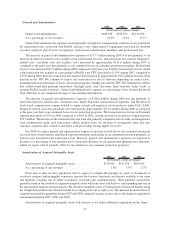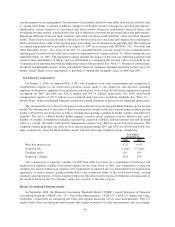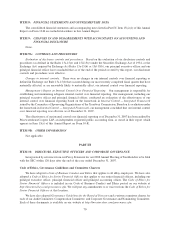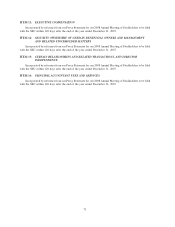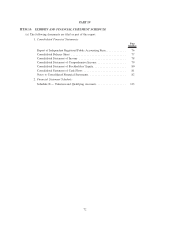eBay 2007 Annual Report Download - page 77
Download and view the complete annual report
Please find page 77 of the 2007 eBay annual report below. You can navigate through the pages in the report by either clicking on the pages listed below, or by using the keyword search tool below to find specific information within the annual report.does not require any new fair value measurements. FAS 157 is effective for fiscal years beginning after Novem-
ber 15, 2007. However on December 14, 2007, the FASB issued a proposed staff position that would delay the
effective date of FAS 157 for nonfinancial assets and nonfinancial liabilities to fiscal years beginning after
November 15, 2008. We do not believe that the adoption of FAS 157 will materially impact our financial position,
cash flows or results of operations.
In February 2007, the FASB issued SFAS No. 159, “The Fair Value Option for Financial Assets and Financial
Liabilities — Including an Amendment of FASB Statement No. 115,” (“FAS 159”) which is effective for fiscal
years beginning after November 15, 2007. This statement permits an entity to choose to measure many financial
instruments and certain other items at fair value at specified election dates. Subsequent unrealized gains and losses
on items for which the fair value option has been elected will be reported in earnings. We do not believe that the
adoption of FAS 159 will materially impact our financial position, cash flows or results of operations.
In December 2007, the FASB issued SFAS No. 141 (Revised 2007), “Business Combinations” (“FAS 141(R)”).
FAS 141(R) establishes principles and requirements for how an acquirer in a business combination recognizes and
measures in its financial statements the identifiable assets acquired, liabilities assumed, and any noncontrolling
interests in the acquiree, as well as the goodwill acquired. Significant changes from current practice resulting from
FAS 141(R) include the expansion of the definitions of a “business” and a “business combination.” For all business
combinations (whether partial, full or step acquisitions), the acquirer will record 100% of all assets and liabilities of
the acquired business, including goodwill, generally at their fair values; contingent consideration will be recognized
at its fair value on the acquisition date and, for certain arrangements, changes in fair value will be recognized in
earnings until settlement; and acquisition-related transaction and restructuring costs will be expensed rather than
treated as part of the cost of the acquisition. FAS 141(R) also establishes disclosure requirements to enable users to
evaluate the nature and financial effects of the business combination. FAS 141(R) applies prospectively to business
combinations for which the acquisition date is on or after the beginning of the first annual reporting period
beginning on or after December 15, 2008. We are currently evaluating the potential impact of this statement.
In December 2007, the FASB issued SFAS No. 160, “Noncontrolling Interests in Consolidated Financial
Statements — An Amendment of ARB No. 51” (“FAS 160”). FAS 160 amends ARB 51 to establish accounting and
reporting standards for the noncontrolling interest in a subsidiary and for the deconsolidation of a subsidiary. It
clarifies that a noncontrolling interest in a subsidiary, which is sometimes referred to as minority interest, is a third-
party ownership interest in the consolidated entity that should be reported as a component of equity in the
consolidated financial statements. Among other requirements, FAS 160 requires consolidated statement of
operations to be reported at amounts that include the amounts attributable to both the parent and the noncontrolling
interest. FAS 160 also requires disclosure, on the face of the consolidated income statement, of the amounts of
consolidated net income attributable to the parent and to the noncontrolling interest. FAS 160 is effective for fiscal
years, and interim periods within those fiscal years, beginning on or after December 15, 2008. Earlier adoption is
prohibited. We are currently evaluating the potential impact of this statement.
ITEM 7A: QUANTITATIVE AND QUALITATIVE DISCLOSURES ABOUT MARKET RISK
Interest Rate Risk
The primary objective of our investment activities is to preserve principal while at the same time maximizing
yields without significantly increasing risk. To achieve this objective, we maintain our portfolio of cash equivalents
and short-term and long-term investments in a variety of securities, including government and corporate securities
and money market funds. These securities are generally classified as available for sale and consequently are
recorded on the balance sheet at fair value with unrealized gains or losses reported as a separate component of
accumulated other comprehensive income (loss), net of estimated tax.
Investments in both fixed-rate and floating-rate interest-earning instruments carry varying degrees of interest
rate risk. The fair market value of our fixed-rate securities may be adversely impacted due to a rise in interest rates.
In general, securities with longer maturities are subject to greater interest-rate risk than those with shorter
maturities. While floating rate securities generally are subject to less interest-rate risk than fixed-rate securities,
floating-rate securities may produce less income than expected if interest rates decrease. Due in part to these factors,
our investment income may fall short of expectations or we may suffer losses in principal if securities are sold that
67


